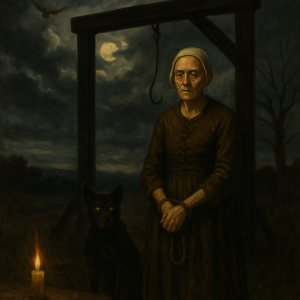Elizabeth Sawyer: Witchcraft Accusation
17th October 2025 by | Uncategorized
The night deepens, and candlelight trembles on the page before me. Beyond the window lies silence, yet in memory the voices of the past return — voices like that of Elizabeth Sawyer of Edmonton, tried and executed in 1621.
Elizabeth was a poor woman, elderly and often quarrelsome. She begged for scraps of firewood, fell into disputes with neighbours, and carried the reputation of an outcast. When misfortune struck her village — when cattle sickened or children fell ill — suspicion gathered around her like storm clouds.
Soon Elizabeth was accused of witchcraft. She denied it at first, but in time, whether through pressure or desperation, she confessed to dealings with a black dog named Tom. This animal, she claimed, appeared to her as a familiar spirit, coaxing her towards the Devil’s path.
Her trial became notorious. Among the witnesses were neighbours whose grievances now sharpened into damning testimony. Their words weighed heavily in a court eager for examples of witchcraft.
Condemned, Elizabeth Sawyer was taken to Tyburn in April 1621. There she was hanged, her frail body swinging before the jeering crowd. Her tale lingered long afterwards, retold upon the stage in Dekker and Ford’s play The Witch of Edmonton.
Her story reminds us how poverty, isolation, and fear could turn a life into legend — and a woman into a witch.
The past is never silent.